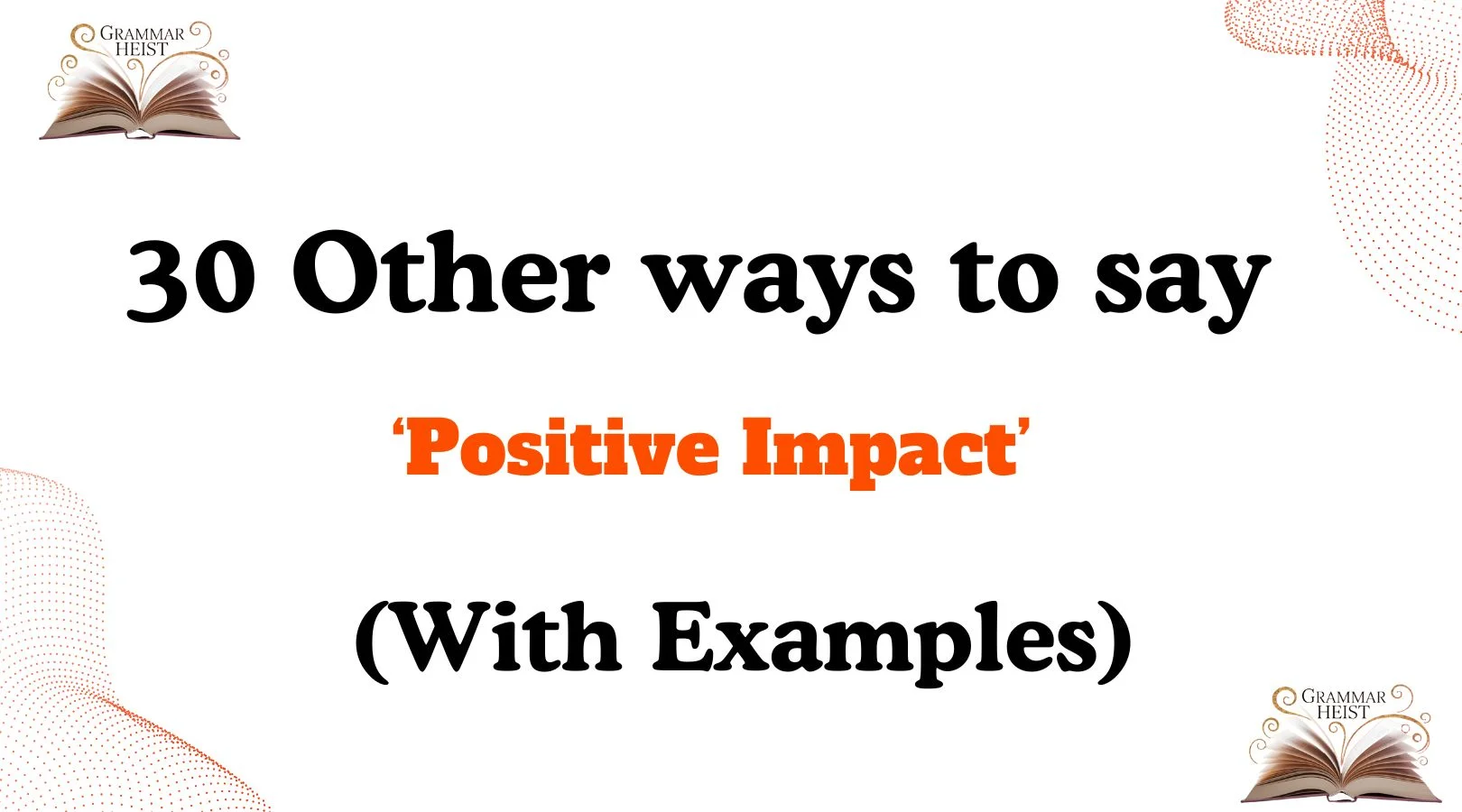Choosing the right words can make a world of difference when expressing appreciation, acknowledgment, or influence. Saying “positive impact” is powerful, but exploring alternatives can make your message feel more personal, thoughtful, and heartfelt. Here’s a guide to 30 other ways to convey that sense of meaningful influence in your communication.
What Does “Positive Impact” Mean?
A positive impact refers to the beneficial influence someone or something has on a person, organization, or situation. It conveys improvement, encouragement, and constructive change.
Is It Professional/Polite to Say “Positive Impact”?
Yes. Using “positive impact” in professional settings is both respectful and polite. It highlights appreciation for someone’s contribution while remaining neutral and professional.
Pros or Cons of Using “Positive Impact”
Pros:
- Universally understood
- Professional and respectful
- Works in many contexts
Cons:
- Overused in workplaces and reports
- Can sound generic or impersonal
Synonyms For “Positive Impact”
- Meaningful Contribution
- Lasting Influence
- Significant Difference
- Valuable Effect
- Beneficial Outcome
- Positive Influence
- Constructive Impact
- Meaningful Effect
- Profound Influence
- Favorable Outcome
- Helpful Contribution
- Constructive Influence
- Appreciable Effect
- Transformative Effect
- Valuable Contribution
- Notable Impact
- Enduring Contribution
- Significant Influence
- Constructive Contribution
- Meaningful Influence
- Beneficial Contribution
- Remarkable Impact
- Inspirational Effect
- Constructive Outcome
- Positive Contribution
- Noteworthy Influence
- Effective Contribution
- Transformational Influence
- Appreciated Contribution
- Meaningful Difference
1. Meaningful Contribution
Scenario: Recognizing someone’s efforts in a team project.
Examples:
- “Your meaningful contribution truly elevated the project’s outcome.”
- “I appreciate your meaningful contribution to our strategy session.”
- “Thanks for making such a meaningful contribution to the event.”
Tone: Warm, professional, appreciative
Explanation: Highlights that the person’s input had significance and value.
2. Lasting Influence
Scenario: Acknowledging mentorship or guidance.
Examples:
- “Your guidance had a lasting influence on my career growth.”
- “The workshop left a lasting influence on our team dynamics.”
- “I hope to honor the lasting influence you’ve had on the project.”
Tone: Reflective, respectful
Explanation: Focuses on enduring effects rather than immediate outcomes.
3. Significant Difference
Scenario: Noticing a change in results due to someone’s effort.
Examples:
- “Your ideas made a significant difference in our presentation.”
- “The donation created a significant difference for the community.”
- “Your efforts made a significant difference in the project’s success.”
Tone: Professional, appreciative
Explanation: Emphasizes measurable or noticeable positive outcomes.
4. Valuable Effect
Scenario: Commenting on contributions to company goals.
Examples:
- “Your suggestions had a valuable effect on our sales strategy.”
- “The team’s collaboration had a valuable effect on productivity.”
- “This initiative will have a valuable effect on client satisfaction.”
Tone: Polite, professional
Explanation: Recognizes the usefulness or advantage of someone’s actions.
5. Beneficial Outcome
Scenario: When results improve a process or situation.
Examples:
- “Your proposal led to a beneficial outcome for our clients.”
- “The changes you implemented created a beneficial outcome for the workflow.”
- “Your leadership ensured a beneficial outcome for the team.”
Tone: Formal, professional
Explanation: Highlights improvement or advantage brought about by an action.
6. Positive Influence
Scenario: Encouraging a peer or colleague.
Examples:
- “Your mentorship has had a positive influence on me.”
- “She brings a positive influence to every meeting.”
- “Your attitude has a positive influence on the team’s morale.”
Tone: Supportive, warm
Explanation: Stresses the motivational or inspiring effect on others.
7. Constructive Impact
Scenario: Offering feedback or professional critique.
Examples:
- “Your feedback had a constructive impact on the project.”
- “The review session had a constructive impact on team performance.”
- “Your comments made a constructive impact on our approach.”
Tone: Professional, encouraging
Explanation: Highlights improvement and development rather than just praise.
8. Meaningful Effect
Scenario: Recognizing someone’s influence on outcomes.
Examples:
- “Your involvement had a meaningful effect on the outcome.”
- “The seminar had a meaningful effect on our perspective.”
- “Your support made a meaningful effect on my confidence.”
Tone: Warm, appreciative
Explanation: Similar to “positive impact,” but with more personal resonance.
9. Profound Influence
Scenario: Acknowledging a life-changing contribution.
Examples:
- “Your mentorship has had a profound influence on my career path.”
- “The book had a profound influence on my thinking.”
- “Her dedication left a profound influence on the team.”
Tone: Deep, respectful
Explanation: Indicates a strong, far-reaching impact.
10. Favorable Outcome
Scenario: Noticing the success of an initiative.
Examples:
- “Your efforts led to a favorable outcome for the clients.”
- “The changes resulted in a favorable outcome for productivity.”
- “Your strategy ensured a favorable outcome for the project.”
Tone: Professional, positive
Explanation: Focuses on the good results achieved.
11. Helpful Contribution
Scenario: Recognizing small but meaningful support.
Examples:
- “Your advice was a helpful contribution to solving the issue.”
- “Thanks for your helpful contribution during the meeting.”
- “Your input was a helpful contribution to the project’s success.”
Tone: Friendly, polite
Explanation: Emphasizes assistance and usefulness.
12. Constructive Influence
Scenario: Improving a team or process.
Examples:
- “Her suggestions had a constructive influence on the plan.”
- “Your feedback created a constructive influence on team morale.”
- “This training had a constructive influence on our workflow.”
Tone: Professional, supportive
Explanation: Focuses on improvement and positive guidance.
13. Appreciable Effect
Scenario: Recognizing a noticeable impact.
Examples:
- “Your hard work had an appreciable effect on our results.”
- “The workshop made an appreciable effect on staff productivity.”
- “Your dedication has an appreciable effect on the team’s success.”
Tone: Polite, professional
Explanation: Highlights noticeable and commendable contributions.
14. Transformative Effect
Scenario: Recognizing dramatic or meaningful change.
Examples:
- “Your leadership had a transformative effect on our department.”
- “The initiative had a transformative effect on our workflow.”
- “Her mentorship had a transformative effect on my career growth.”
Tone: Inspirational, appreciative
Explanation: Emphasizes significant and lasting positive change.
15. Valuable Contribution
Scenario: Highlighting someone’s usefulness.
Examples:
- “Your valuable contribution helped the project succeed.”
- “Thanks for your valuable contribution to the meeting.”
- “We appreciate your valuable contribution to the team’s goals.”
Tone: Polite, appreciative
Explanation: Recognizes importance and benefit of the contribution.
16. Notable Impact
Scenario: Emphasizing visible results.
Examples:
- “Her efforts had a notable impact on sales performance.”
- “The campaign created a notable impact on brand awareness.”
- “Your leadership made a notable impact on project outcomes.”
Tone: Professional, factual
Explanation: Focuses on the significance of the results.
17. Enduring Contribution
Scenario: Recognizing long-term effects.
Examples:
- “His work made an enduring contribution to the organization.”
- “Your mentorship is an enduring contribution to my growth.”
- “The policies introduced have an enduring contribution to efficiency.”
Tone: Respectful, warm
Explanation: Highlights long-lasting benefits.
18. Significant Influence
Scenario: Recognizing someone’s effect on decisions or behavior.
Examples:
- “Your advice had a significant influence on the team’s direction.”
- “The mentor had a significant influence on my approach.”
- “Her presentation had a significant influence on stakeholder decisions.”
Tone: Professional, appreciative
Explanation: Emphasizes measurable or important effects.
19. Constructive Contribution
Scenario: Feedback or support that improves outcomes.
Examples:
- “Your review was a constructive contribution to the report.”
- “Thanks for your constructive contribution to the discussion.”
- “Her suggestions were a constructive contribution to the project’s success.”
Tone: Supportive, professional
Explanation: Highlights contributions that lead to improvement.
20. Meaningful Influence
Scenario: Personal or professional guidance.
Examples:
- “Your guidance has a meaningful influence on my career.”
- “The coach’s advice had a meaningful influence on the team’s performance.”
- “Your dedication has a meaningful influence on our success.”
Tone: Warm, reflective
Explanation: Emphasizes personal or professional impact with depth.
21. Beneficial Contribution
Scenario: Emphasizing positive assistance.
Examples:
- “Your efforts were a beneficial contribution to our project.”
- “The volunteer’s work was a beneficial contribution to the event.”
- “Your participation made a beneficial contribution to the discussion.”
Tone: Polite, professional
Explanation: Recognizes the usefulness and advantage of efforts.
22. Remarkable Impact
Scenario: Highlighting extraordinary results.
Examples:
- “Her initiative had a remarkable impact on community outreach.”
- “Your innovation created a remarkable impact on efficiency.”
- “The campaign achieved a remarkable impact on engagement.”
Tone: Enthusiastic, professional
Explanation: Emphasizes strong, noticeable positive results.
23. Inspirational Effect
Scenario: Motivating or encouraging others.
Examples:
- “Your speech had an inspirational effect on the team.”
- “The leader’s dedication had an inspirational effect on staff.”
- “Your story created an inspirational effect on the audience.”
Tone: Warm, uplifting
Explanation: Highlights motivation and encouragement.
24. Constructive Outcome
Scenario: Resulting from guidance, effort, or planning.
Examples:
- “Your feedback led to a constructive outcome in our project.”
- “The training had a constructive outcome on team efficiency.”
- “Her advice resulted in a constructive outcome for our strategy.”
Tone: Professional, encouraging
Explanation: Emphasizes improvement and effective results.
25. Positive Contribution
Scenario: General acknowledgment of helpfulness.
Examples:
- “Your positive contribution improved the meeting outcomes.”
- “Thanks for your positive contribution to the initiative.”
- “The team appreciated your positive contribution to the project.”
Tone: Friendly, professional
Explanation: Recognizes helpfulness and constructive efforts.
26. Noteworthy Influence
Scenario: Recognizing someone’s important effect.
Examples:
- “Her guidance had a noteworthy influence on my career choice.”
- “The speaker had a noteworthy influence on the team’s approach.”
- “Your mentorship provided a noteworthy influence on the project.”
Tone: Professional, appreciative
Explanation: Highlights effects that deserve attention and recognition.
27. Effective Contribution
Scenario: Acknowledging actions that achieved results.
Examples:
- “Your effective contribution streamlined our workflow.”
- “The team’s effective contribution improved client satisfaction.”
- “Her effective contribution made the project a success.”
Tone: Professional, encouraging
Explanation: Emphasizes practical, successful results.
28. Transformational Influence
Scenario: Highlighting major, positive change.
Examples:
- “Her leadership had a transformational influence on the department.”
- “The program had a transformational influence on our efficiency.”
- “Your mentorship created a transformational influence on my development.”
Tone: Inspirational, professional
Explanation: Indicates a strong, positive, and lasting change.
29. Appreciated Contribution
Scenario: Recognizing efforts with gratitude.
Examples:
- “Your appreciated contribution helped us meet the deadline.”
- “We value your appreciated contribution to the team.”
- “Your efforts are an appreciated contribution to our goals.”
Tone: Warm, polite
Explanation: Combines recognition with gratitude.
30. Meaningful Difference
Scenario: Showing the importance of someone’s actions.
Examples:
- “Your mentorship made a meaningful difference in my career.”
- “The volunteer work created a meaningful difference in the community.”
- “Your ideas made a meaningful difference to the project outcome.”
Tone: Supportive, warm
Explanation: Highlights that the actions truly mattered and were impactful.
Conclusion
Finding alternative ways to say ‘positive impact’ can elevate your communication, making it more personal, empathetic, and thoughtful. Using these expressions ensures your message resonates, acknowledges contributions meaningfully, and encourages continued positivity.

Emma Brooke is a passionate advocate for effective communication and language mastery. As a dedicated professional in the field of grammar and writing, Emma brings a wealth of knowledge and expertise to those seeking to improve their linguistic skills. With a focus on clarity, precision, and style, Emma Brooke is committed to helping individuals refine their language use to communicate confidently and effectively.












